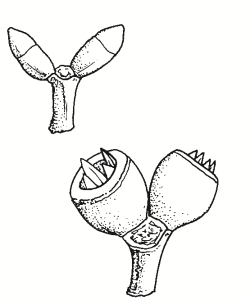Family:
Myrtaceae
Eucalyptus goniocalyx
Long-leaf Box
(syn. E. elaeophora)
Other Names: Bundy
First Nations Name(s):

Name Origin:
goniocalyx — from Greek gonia, angle or corner, and calyx, sepals collectively, referring to bud shape.
Regional Subspecies:
Similar Species:
Long-leaf Box and Silver Bundy (E. nortonii) are virtually identical except that Silver Bundy has glaucous (white-waxy) buds, fruit and branchlets whereas Long-leaf Box does not. Both are distinguished from Apple Box (E. bridgesiana) by their larger fruits and buds.
Occurrence:
Regional:
In most of the region except in the far west and north-west.
Australia:
NSW, Vic, SA.
Habitat:
Open grassy or sclerophyll woodland. Dry shallow soils on sloping sites.
Habit:
Trees to 15 m high with fibrous flaky grey bark with whitish patches, shedding in short ribbons above. Narrow green adult leaves.
Site Preference:
Infertile soil on dry and rocky areas. Tolerates drought and moderate frost.
Characteristics:
Moderate growth rate. Foliage high in cineole, useful in medicine.
Flowering:
White-cream, Mar-May.
Seed Collection:
Throughout year, particularly summer-autumn. Seeds generally retained.
Propagation:
From seed (± 127 viable seeds per gram). 25°C is optimum germination temperature.
Regeneration:
From seed, particularly in absence of competitive exotic grasses or weeds, and during wet summers. Often regenerates on infertile sites due to lack of weed competition. Establishes very well when direct seeded.
VALUES:
Shade & Shelter:
Useful medium-level cover in windbreaks. Useful shade due to dense canopy and suitability for harsh exposed hilltops.
Land Protection:
Useful for revegetating unproductive, rocky recharge hills.
Wildlife:
Excellent habitat. Foliage is koala forage. Nectar-feeding birds attracted to flowers, which are pollen-rich. Insect-eating birds such as thornbills find insects amongst foliage. White-throated Treecreepers and sittellas glean bark. Fruits and seeds eaten by native birds, particularly parrots. Hollows are nesting and refuge sites for native birds and mammals.
Fuel:
Fair. Easily split and burns fast.
Timber:
Little value. Timber yellow-grey, coarse-grained and not durable. Sapwood decays rapidly.
Ornamental:
Juvenile foliage particularly attractive.
Other:
Leaves produce range of dyes depending on mordants used.
